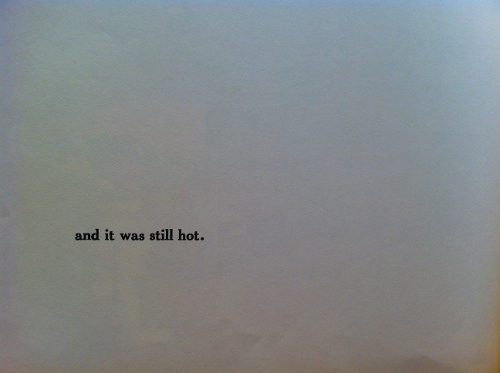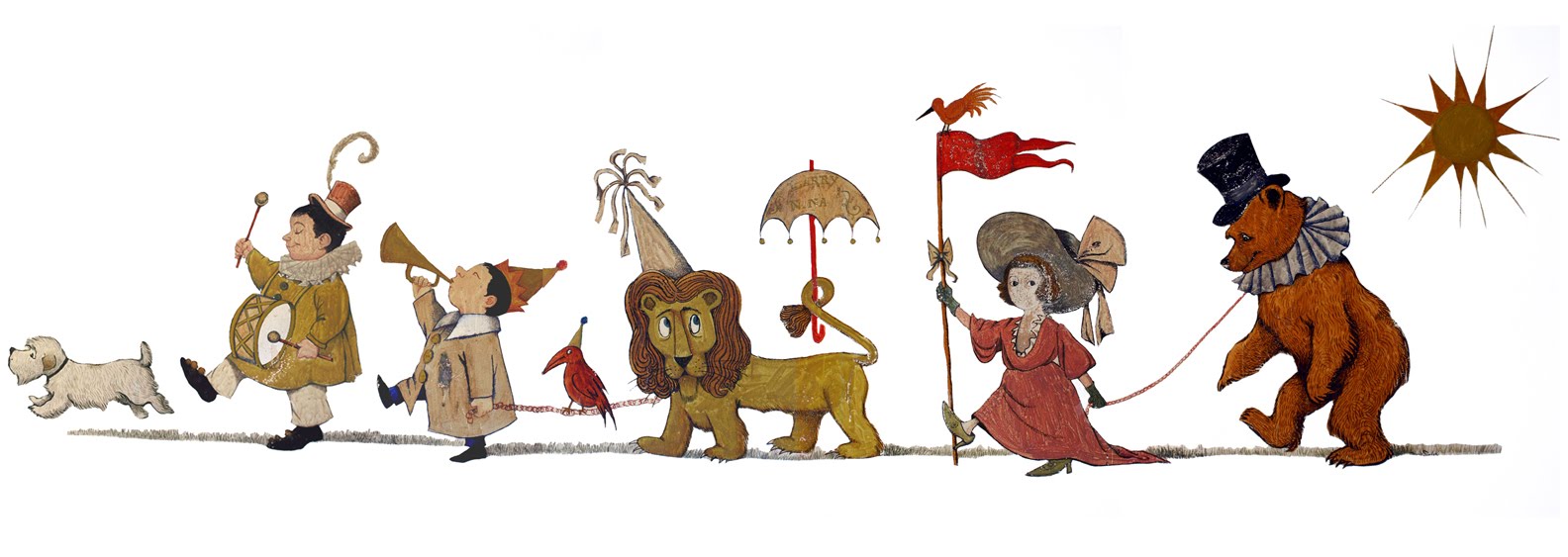‘One of Sendak's most lovingly rendered pages, one of his most graphically succinct and nonetheless articulate expressions of deep meaning." --From Gregory Maguire's "A Sendak Appreciation," The Horn Book, November/December 2003Be Still
Maurice Sendak
June 10, 1928-May 8, 2012
(Tributes to Maurice Sendak came in from everywhere when news of his death broke on May 8. Some-many, in fact--such as the one by Roger Sutton ["My Friend Maurice"] posted at The Horn Book are written from the vantagepoint of those who knew the famous illustrator and experienced his passing in very personal terms. Others, such as the following remembrance from the Rosenbach Museum & Library in Philadelphia, an institution with which Mr. Sendak had a long and fruitful relationship, strike a balance between being both objective and subjective in their thoughts about the man. In the end, the subjective wins out, because readers of all ages knew Maurice Sendak--from his books if nothing else--on very personal terms, for a variety of reasons. So it is that those speaking on behalf of this distinguished art museum do so not from a distance but from the heart in reflecting on the Honorary President of its Board of Trustees, who just happened to be the author of Where the Wild Things Are.)
It is with great sadness that the Rosenbach Museum & Library says goodbye to its longtime trustee, supporter and all-around good friend Maurice Sendak, whose work is a cornerstone of the museum's collection. Mr. Sendak died following a massive stroke on May 8, 2012. He was 83, and had written or illustrated nearly 100 books in a sixty-five year career during which he received every conceivable honor.
Maurice Bernard Sendak was born in Brooklyn on June 10, 1928. His father was an immigrant from Poland-the "black sheep" of the family, sent to America to work as a tailor in order to support his family back home. The annihilation of the family during the Holocaust created a profound sense of guilt even in the young Maurice, who wrestled with the topic throughout his life. His 2003 Brundibar is a magisterial distillation of this theme. The Yiddish language and Jewish customs that filled his household infused most of his books with Old World stories, images, and an ever-present sense of loss. His best-known book, the 1963 Where the Wild Things Are, was later revealed to have been based on the aunts and uncles who wanted to "eat him up."
Mr. Sendak was sickly as a child and could rarely join other children in their play, but his gift for storytelling brought the whole neighborhood to the front steps of the Sendak home, where he would regale them with stories. He was captivated by news stories and cultural developments of the 1920s and 1930s alike, from the introduction of Mickey Mouse in 1928 (the source of a lifelong collecting interest in his "twin") to the Lindbergh kidnapping in 1932 (a nightmare that found its way into his Outside Over There from 1981), to the New York World's Fair in 1939 (where his older sister ditched him, an experience he transformed into In the Night Kitchen in 1971).
Maruice Sendak's Chertoff Mural, which the Rosenbach had acquired and restored beginning in 2008. Maurice Sendak painted this mural on the wall of his friends' New York apartment, completing it in 1961. The leader of the procession is Sendak's own dog, Jennie, who had already appeared in his books Kenny's Window (1956) and What Do You Say, Dear? (1958); she would later turn up as Max's dog in Where the Wild Things Are (1963) in a nearly identical pose. The parade of Sendakian figures continues with a girl who resembles Rosie--the dramatic title character from The Sign on Rosie's Door (1960) and Sendak's future TV special Really Rosie (1975)--as well as a bear who seems to spring from the pages of the Little Bear Series, which Sendak illustrated for Else Holmelund Minarik. This collection of past and future Sendakian characters is the only surviving mural by Maurice Sendak.It would be difficult to think of a better-known illustrator of the twentieth-century, yet Mr. Sendak all but lacked any formal training as such. His childhood hobby of drawing, and a lucky break that enabled him to decorate store windows for F.A.O. Schwartz, brought him into contact with the legendary Ursula Nordstrom, editor of children's books at Harper & Row (now HarperCollins). She nurtured his career in a way he never forgot; late in life he went on to create a fellowship program so that he could nurture other young illustrators.
Mr. Sendak often lamented that he was stamped an illustrator rather than an artist in his own right. He also bristled at the notion that he wrote for children, contending that he did not write for any special audience, and explaining that in his view, children simply had a special understanding of his work. He was a creative genius who turned everything he touched into something special, and today no one can seriously maintain he does not deserve the highest accolades as a true artist.
Removing the Chertoff Mural from its original locationIn 1966, Maurice Sendak first visited the Rosenbach Museum & Library in Philadelphia, following a tip that the Rosenbach--virtually unknown at the time--was home to important collections of Herman Melville, by far his favorite author. He found not only Melville in the collections, but Nathaniel Hawthorne, Emily Dickinson, William Blake, and many other giants from the nineteenth-century canon that defined Mr. Sendak's literary, artistic and musical tastes. In 1968, he began to place his original drawings for the various books he had illustrated on deposit at the Rosenbach. In 1973, after his friend and onetime neighbor Marianne Moore bequeathed her library to the Rosenbach, he joined the board of trustees of the institution. Mr. Sendak was named Honorary President of the board of trustees of the Rosenbach in 2003, in acknowledgment of his enormous contributions to the life of the institution; the museum simultaneously named part of its expanded premises in his honor. A gallery dedicated to his work has long been one of the highlights of the Rosenbach and continues to feature original drawings to this day in a series of rotating exhibitions.
'I wanted so not to screw up their wall. Do something nice.': Maurice Sendak on creating the Chertoff MuralMr. Sendak made his final visit to the Rosenbach in April 2012, when he came to see the new installation of his only surviving monumental-scale work, the so-called Chertoff mural, which the Rosenbach had acquired and restored beginning in 2008. Of course, generations of families who have grown up with his incredible books would claim there are many in the corpus that are monumental, and it is hard to say they are wrong. Indeed, through his work, Mr. Sendak will live on to inspire many more generations of "children of all ages."
Early fame put pressure on Mr. Sendak to cultivate a public persona that was curmudgeonly, cynical, even aloof. Those who were granted access to his private sphere, however, know that the real Maurice Sendak was a generous host, an erudite student with well-founded opinions on art, music and literature, and the best friend anybody could have. Mr. Sendak was completely devoted to his partner in life, Dr. Eugene Glynn, for fifty years, though he only talked openly about his homosexuality late in life. The passing of Dr. Glynn in 2007 left Mr. Sendak unable to work for a long period of time, during which many assumed he had simply retired. An artist right down to the melancholic core, retire was the one thing Mr. Sendak could never do. He was driven to write and draw-and read and listen-until the very end. If we are lucky, some of what was on his drafting table in recent months will eventually find its way into print.
Maurice Sendak was a national treasure and a "mensch" all rolled into one. His loss is staggering for friends and family, to whom the Rosenbach offers its deepest condolences. His gifts to the world will live on, and the Rosenbach is proud to be a partner in the effort to share them.
Derick Dreher
John C. Haas, Director
Rosenbach Museum & Library
Founder/Publisher/Editor: David McGee
Contributing Editors: Billy Altman, Laura Fissinger, Christopher Hill, Derk Richardson
Logo Design: John Mendelsohn (www.johnmendelsohn.com)
Website Design: Kieran McGee (www.kieranmcgee.com)
Staff Photographers: Audrey Harrod (Louisville, KY; www.flickr.com/audreyharrod), Alicia Zappier (New York)
E-mail: thebluegrassspecial@gmail.com
Mailing Address: David McGee, 201 W. 85 St.—5B, New York, NY 10024




